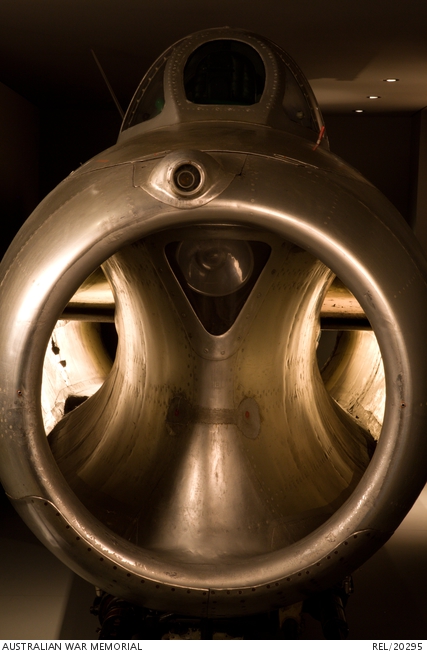| Place | Asia: Russia |
|---|---|
| Accession Number | REL/20295 |
| Collection type | Technology |
| Object type | Aircraft |
| Location | Main Bld: Aircraft Hall: Main Hall: Mustang |
| Place made | Union of Soviet Socialist Republics |
| Date made | 1951 |
| Conflict |
Korea, 1950-1953 |
MiG-15bis Fighter Aircraft



Complete type example of a Soviet designed and made all metal MiG-15bis fighter aircraft. The aircraft has a clear perspex 'blister' canopy for the one pilot, rearward swept wings mounted to a short fuselage with a large intake at the front. The complete original radio communications equipment is included with the aircraft. The engine consists of a single Klimov VK-1 centrifugal flow turbojet delivering maximum static thrust of 5,922lbs (2,700kg). The Klimov engine is an unlicenced Russian reverse-engineered copy of the Rolls Royce 'Nene' engine. The installed armament consists of one 37mm N-37 cannon (starboard/right side), and two NR-23 cannon (both on port/left side of fuselage). There are no squadron or unit markings applied to the aircraft, with only the Soviet Air Force style red stars in all standard positions. The aircraft is in natural metal finish.
The Soviet designed and made MiG-15 fighter was first introduced to combat during the Korean War in November 1950. It was operated by Communist Chinese, North Korean and Russian air units and soon forced the United Nations (UN) countries, including Australia, to commit more advanced aircraft to the war. As part of the UN force in Korea, 77 Squadron RAAF initially flew propeller driven P-51 Mustangs, but later was re-equipped with jet powered British designed and made Gloster Meteor Mk8's.
After a number of combats it became clear that the Meteor was outclassed by the MiG-15, particularly at high altitude. Australian losses were such that the Meteors were eventually switched successfully to bomber escort and ground attack roles.
This example is an original Soviet built MiG-15bis variant which was discovered in Russia in 1992. It is of the same type and production batch as MiGs known to have flown during the Korean conflict. According to an interrogation report of a 1953 North Korean defector, about 900 MiGs saw service during the conflict. About 100 were flown by North Koreans, 400 by the Chinese and 400 by Soviet pilots. There are several published reports written post-Korean War by Russian Regimental Commanders on their aerial combats between their MiG-15's and Australian Meteors in Korea. An example can be found published in the book "MiG-15" by Y. Gordon and V. Rigmant which was published by Motorbooks in 1993.
There are only three other Soviet built MiG-15bis known to be preserved. The Memorial acquired this aircraft in 1993. The forward fuselage and engine of the MiG-15 are on display in Aircraft Hall of the Australian War Memorial.